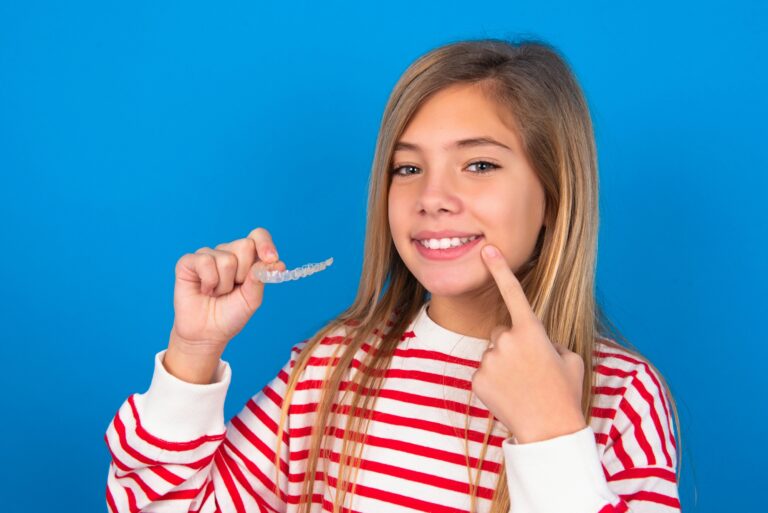Will Invisalign Work for Me? Here’s How You Can Tell
Understanding Invisalign
What Is Invisalign?
Invisalign is a modern orthodontic treatment that straightens teeth using a series of custom-made, clear aligners. Unlike traditional metal braces, these aligners are nearly invisible, making them a popular choice for teens and adults who want a discreet solution for improving their smile.
Each aligner is made from a smooth, BPA-free plastic material and is designed to fit snugly over the teeth. Over time, the aligners apply gentle pressure, gradually shifting teeth into their correct positions. Since there are no metal brackets or wires, Invisalign offers a more comfortable and aesthetically pleasing alternative to traditional braces. Invisalign Teen also offers aligners specifically designed for a teenage lifestyle.
Today, over 19 million people have used Invisalign!

How Invisalign Works
Invisalign treatment follows a step-by-step process beginning with a free Invisalign consultation, ensuring gradual and precise tooth movement:
- Custom Aligners: Your orthodontist takes 3D scans or impressions of your teeth to create a series of aligners specifically designed for your treatment plan.
- Wearing Aligners: Each set of aligners must be worn for 20–22 hours per day, only removed when eating, drinking (except for water), or brushing teeth.
- Switching Aligners: Every one to two weeks, you’ll switch to a new set of aligners. Each set applies slightly different pressure to continue the movement of your teeth.
- Gradual Shifting: Over time, your teeth move millimeter by millimeter, eventually aligning into their ideal position.
- Check-Ups: Periodic visits to your orthodontist ensure that your treatment stays on track, with adjustments made as needed.
| Invisalign Treatment Steps | Timeframe |
| Initial consultation & scans | 1 appointment |
| Custom aligner creation | 2–4 weeks |
| Wearing each aligner set | 1–2 weeks per set |
| Full treatment duration | 12–18 months (varies by case) |
| Retainers after treatment | Nightly wear recommended |
Advantages of Invisalign
Choosing Invisalign offers several key benefits compared to traditional braces:
- Nearly Invisible: The clear aligners blend in with your teeth, making them discreet and unnoticeable in social and professional settings.
- Removable for Convenience: Unlike metal braces, you can take out your aligners when eating, brushing, and flossing—allowing you to maintain better oral hygiene.
- Comfortable Fit: With no wires, brackets, or sharp edges, Invisalign aligners cause less irritation to the gums and cheeks.
- Fewer Office Visits: Since Invisalign doesn’t require tightening like traditional braces, check-ups are typically less frequent.
- Predictable Results: Advanced digital planning technology allows you to see a preview of your expected results before starting treatment.
For those seeking a comfortable, flexible, and aesthetically pleasing way to straighten their teeth, Invisalign is an excellent solution.
Will Invisalign Work for You? Who Is a Good Candidate for Invisalign
Dental Issues Invisalign Can Fix
Invisalign is an effective treatment for mild to moderate orthodontic issues, making it a great option for those who need minor adjustments without the look and feel of traditional braces.
If you have any of the following dental concerns, you may be a good candidate for Invisalign:
- Gapped Teeth – If you have noticeable spaces between your teeth, Invisalign can help close them, improving both function and appearance.
- Crowded Teeth – When teeth are too close together, they can be difficult to clean, leading to a higher risk of cavities and gum disease. Invisalign can gradually create proper spacing.
- Overbite – This occurs when the upper teeth extend too far over the lower teeth, sometimes causing excessive wear or jaw discomfort. Invisalign can realign the bite for a more balanced smile.
- Underbite – When the lower teeth sit in front of the upper teeth, it can cause issues with chewing and speech. Invisalign can help shift the lower teeth back for better alignment.
- Crossbite – If some of your upper teeth sit inside the lower teeth when you bite down, it can lead to tooth wear and gum recession. Invisalign can help reposition the teeth properly.
If your case is moderate to mild, Invisalign can be an excellent alternative to traditional braces. However, more severe dental concerns may require additional treatment before Invisalign can be considered.
Cases Where Invisalign May Not Work
While Invisalign is effective for many cases, it isn’t the right fit for everyone. Some dental and structural issues require more advanced orthodontic treatments, such as:
- Severe Misalignment – If your teeth are extremely crooked or require significant movement, traditional braces may be necessary for precise correction.
- Jaw Structure Problems – Issues like a severe overbite, underbite, or crossbite caused by the jawbone’s position may require orthodontic appliances or surgery for correction.
- Large Gaps or Rotations – If teeth need to be rotated significantly or if there are large spaces to close, Invisalign alone may not be effective.
- Lack of Commitment – Invisalign is a removable treatment, meaning patients need to wear aligners for 22 hours a day. If you frequently forget to wear them, treatment results may be compromised.
In some cases, orthodontists recommend starting with braces and then switching to Invisalign for finishing touches. If you’re unsure whether Invisalign will work for you, an orthodontic consultation is the best way to find out.
Age Considerations for Invisalign
Invisalign is ideal for older teenagers and adults, but it may not be suitable for everyone depending on age and dental development.
- Teenagers & Young Adults – Invisalign is a great choice for teens who have all their permanent teeth and are responsible enough to wear the aligners as required. Invisalign Teen is a great option, with built in eruption tabs and compliance indicators.
- Children & Pre-Teens – Young children who still have baby teeth or growing jaws may not be suitable candidates for Invisalign since their teeth are still shifting naturally.
- Older Adults – Invisalign is also effective for adults and seniors who want to improve their smiles. As long as gums and bone structure are healthy, age is not a limiting factor.
Read more about Invisalign Teen benefits and costs
If you’re unsure whether age is a factor, a consultation with an orthodontist can help determine the best course of action for your needs.
Commitment Required for Success
One of the biggest factors in whether Invisalign will work for you is your commitment to the treatment process. Since Invisalign aligners are removable, their effectiveness depends on consistent wear and proper maintenance.
- Wearing Aligners for at Least 22 Hours Daily – Aligners should only be removed for eating, drinking anything besides water, brushing, and flossing. The more consistently they are worn, the faster and more effective the results.
- Keeping Aligners Clean & Maintaining Oral Hygiene – Aligners should be cleaned daily to prevent bacteria buildup and staining. Good oral hygiene, including brushing and flossing, ensures healthy teeth and gums throughout treatment.
- Attending Regular Check-Ups – Orthodontic visits are necessary to monitor progress and make adjustments. Skipping appointments can delay treatment and lead to less effective results.
By following these commitment guidelines, Invisalign patients can achieve a straighter, healthier smile with minimal disruption to their daily lives.

Key Factors That Influence Invisalign Success
Severity of Alignment Issues
The complexity of your dental misalignment plays a significant role in determining how effective Invisalign will be for you. Mild to moderate cases see the best results, as Invisalign is designed to correct common issues like crowded teeth, gaps, and minor bite problems.
For more severe misalignment, traditional braces may be required first to make major adjustments before transitioning to Invisalign for fine-tuning.
Cases that involve significant jaw misalignment or large tooth movements might need surgical intervention or special orthodontic appliances.
Consistency in Wearing Aligners
Invisalign only works if you wear the aligners as prescribed. They must be worn for at least 22 hours per day, removed only for eating, drinking (except water), and brushing.
Forgetting to wear them or frequently removing them can prevent teeth from shifting as planned, leading to treatment delays, ineffective results, or even the need for refinements.
For best results:
- Keep aligners in at all times except for meals and oral hygiene.
- Use a case when not wearing aligners to prevent loss or damage.
- Stay on schedule with aligner changes to maintain progress.
Oral Hygiene & Maintenance
Since Invisalign aligners cover your teeth for most of the day, good oral hygiene is essential to prevent plaque buildup, staining, and bad breath.
- Brush & floss after every meal before reinserting aligners.
- Clean aligners daily with mild soap and lukewarm water.
- Avoid sugary and acidic foods that can contribute to cavities.
Skipping proper hygiene can lead to gum inflammation, enamel damage, and stained aligners, which affects both oral health and treatment results.
Smoking & Lifestyle Habits
Smoking and poor dietary habits can negatively impact Invisalign treatment.
- Smoking stains aligners, making them yellow and unattractive.
- Tobacco use increases the risk of gum disease, which can delay treatment.
- High sugar intake leads to cavities, requiring dental work that may disrupt Invisalign progress.
Schedule Your Free Consultation
Why Choose Longmont Braces?
When it comes to Invisalign treatment, choosing the right orthodontist makes all the difference. Dr. Ross at Longmont Braces has years of experience helping patients achieve their perfect smiles using clear aligners.
At Longmont Braces, we believe in a personalized approach to orthodontic care. Every patient receives a custom treatment plan based on their unique dental needs. Whether you’re correcting crowding, gaps, or bite issues, Dr. Ross will ensure your treatment is efficient and effective.
Why patients choose Longmont Braces:
- Expert Invisalign provider with a track record of success.
- Customized treatment plans designed for your specific goals.
- State-of-the-art technology for accurate treatment planning.
- Comfortable, welcoming environment with a patient-first approach!
Book Your Consultation Today
Getting started with Invisalign is easy! Schedule your free consultation today by calling (303) 772-0510 or filling out this form.
During your visit, Dr. Ross will evaluate your teeth, discuss your goals, and outline the best treatment plan for you. Take the first step toward a healthier, straighter smile—book your appointment today!







